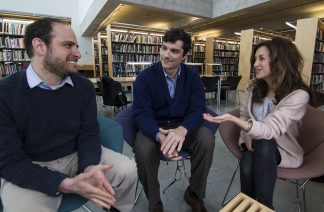By Jon Jeffryes

Scott Spicer (left) with Architecture Professor Greg Donofrio, and Arts & Architecture Librarian Deborah Ultan
Research projects are changing. In this dynamic landscape the University of Minnesota Libraries continues to evolve its services to foster the academic success of students.
Digital storytelling is a new format of research assignment and Scott Spicer, Media Outreach and Learning Spaces Librarian, provides leadership for instructors and students in this emerging area. Spicer has collaborated on over 225 student video assignments.
“It’s just a really, really exciting time,” Spicer says.
What is digital storytelling?
Digital storytelling is the label applied to a variety of videos that combine analytical scholarly investigation, and creative storytelling. There are four main types of digital storytelling: personal narrative, investigative documentary, recorded slide presentation, and public service announcement.
These projects improve students’ ability to concisely and compellingly communicate their ideas and research findings. They also improve students’ media literacy — learning firsthand about the choices video creators employ to influence audiences allows them to apply that knowledge when they encounter and evaluate video news on social media or television.
Spicer describes digital storytelling as “a catalyst for critical thinking.”
‘Scott helped me develop and implement every aspect of the assignment’
Spicer recently partnered with Architecture Professor Greg Donofrio to transform a research paper assignment into a digital storytelling project. Donofrio found that, for most students, his previous assignment of writing a literature review, “did not motivate their interests or make use of their creativity.”
Early in the process Donofrio reached out to Spicer for collaboration.
“Scott helped me develop and implement every aspect of the assignment,” Donofrio says. “This involved developing overall specifications, schedule, and deliverables for the assignment, which gave my students a clear sense of what was expected and when. But it still preserved plenty of opportunities for them to think creatively about their topics and the formats of their videos.”
“I can work with instructors to leverage the potential to meet the learning objectives,” Spicer says, “and match those with the support resources we have in the libraries and on campus.”
Arts & Architecture Librarian Deborah Ultan sees a direct connection between this new form of research product and traditional library research skills.
“Students made quality use of primary sources and background research to tell their stories,” she says, adding that she and Spicer are currently working with Donofrio to integrate library research instruction into the class and evaluation of sources into the grading rubric.
Ultan calls it an ideal partnership where librarians and instructors “team up so content development and critical thinking and translation of the research into video production is a collaborative teaching process.”
Along with collaborating on the assignment and assisting with library research, the Libraries further supports student video projects through the SMART Learning Commons. The SMART Learning Commons has cameras and microphones available for checkout, video editing and production software on its computers, and a media specialist and student workers trained to provide assistance.
‘It’s harder to reach instructors who haven’t thought about this possibility’
The biggest challenge Spicer faces in supporting these video projects is getting the word out. “It’s harder to reach instructors who haven’t thought about this possibility and to show them the different options.”
Spicer and media colleagues across campus decided to take on that challenge.
With the aim “to develop an online resource to reach our instructors on the potential of the projects in course integration,” Spicer and his colleagues created a free online class. Wanting their work to benefit the widest audience they also made it available to K-12 instructors across the state. The course includes case study assignments with workflows, scaffolding, example videos and support resources.
‘I see these projects becoming even richer in terms of scholarship’
Spicer stresses that these projects are iterative and he continues to work with faculty to adapt their assignments as both instructor and students get more comfortable with digital storytelling.
Spicer is excited about where the format is going.
“I see these projects becoming even richer in terms of scholarship,” Spicer said, “I see them being an increasingly more sophisticated in terms of their pedagogical contexts.”
A variety of case studies that Spicer has supported can be found on the Libraries’ website.
View some of the projects




